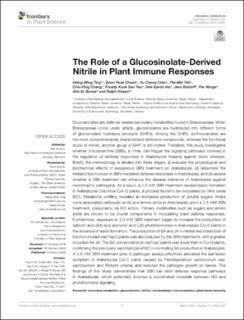| dc.contributor.author | Ting, Hieng Ming | |
| dc.contributor.author | Cheah, Boon Huat | |
| dc.contributor.author | Chen, Yu-Cheng | |
| dc.contributor.author | Yeh, Pei-Min | |
| dc.contributor.author | Cheng, Piu-Ching | |
| dc.contributor.author | Yeo, Freddy Kuok San | |
| dc.contributor.author | Vie, Ane Kjersti | |
| dc.contributor.author | Rohloff, Jens | |
| dc.contributor.author | Winge, Per | |
| dc.contributor.author | Bones, Atle M. | |
| dc.contributor.author | Kissen, Ralph | |
| dc.date.accessioned | 2020-03-27T09:47:25Z | |
| dc.date.available | 2020-03-27T09:47:25Z | |
| dc.date.created | 2020-03-25T18:17:30Z | |
| dc.date.issued | 2020 | |
| dc.identifier.issn | 1664-462X | |
| dc.identifier.uri | https://hdl.handle.net/11250/2649050 | |
| dc.description.abstract | Glucosinolates are defense-related secondary metabolites found in Brassicaceae. When Brassicaceae come under attack, glucosinolates are hydrolyzed into different forms of glucosinolate hydrolysis products (GHPs). Among the GHPs, isothiocyanates are the most comprehensively characterized defensive compounds, whereas the functional study of nitriles, another group of GHP, is still limited. Therefore, this study investigates whether 3-butenenitrile (3BN), a nitrile, can trigger the signaling pathways involved in the regulation of defense responses in Arabidopsis thaliana against biotic stresses. Briefly, the methodology is divided into three stages, (i) evaluate the physiological and biochemical effects of exogenous 3BN treatment on Arabidopsis, (ii) determine the metabolites involved in 3BN-mediated defense responses in Arabidopsis, and (iii) assess whether a 3BN treatment can enhance the disease tolerance of Arabidopsis against necrotrophic pathogens. As a result, a 2.5 mM 3BN treatment caused lesion formation in Arabidopsis Columbia (Col-0) plants, a process found to be modulated by nitric oxide (NO). Metabolite profiling revealed an increased production of soluble sugars, Krebs cycle associated carboxylic acids and amino acids in Arabidopsis upon a 2.5 mM 3BN treatment, presumably via NO action. Primary metabolites such as sugars and amino acids are known to be crucial components in modulating plant defense responses. Furthermore, exposure to 2.0 mM 3BN treatment began to increase the production of salicylic acid (SA) and jasmonic acid (JA) phytohormones in Arabidopsis Col-0 plants in the absence of lesion formation. The production of SA and JA in nitrate reductase loss-of function mutant (nia1nia2) plants was also induced by the 3BN treatments, with a greater induction for JA. The SA concentration in nia1nia2 plants was lower than in Col-0 plants, confirming the previously reported role of NO in controlling SA production in Arabidopsis. A 2.0 mM 3BN treatment prior to pathogen assays effectively alleviated the leaf lesion symptom of Arabidopsis Col-0 plants caused by Pectobacterium carotovorum ssp. carotovorum and Botrytis cinerea and reduced the pathogen growth on leaves. The findings of this study demonstrate that 3BN can elicit defense response pathways in Arabidopsis, which potentially involves a coordinated crosstalk between NO and phytohormone signaling. | en_US |
| dc.language.iso | eng | en_US |
| dc.publisher | Frontiers | en_US |
| dc.relation.uri | https://www.frontiersin.org/articles/10.3389/fpls.2020.00257/pdf | |
| dc.rights | Navngivelse 4.0 Internasjonal | * |
| dc.rights.uri | http://creativecommons.org/licenses/by/4.0/deed.no | * |
| dc.title | The Role of a Glucosinolate-Derived Nitrile in Plant Immune Responses | en_US |
| dc.type | Peer reviewed | en_US |
| dc.type | Journal article | en_US |
| dc.description.version | publishedVersion | en_US |
| dc.source.volume | 11 | en_US |
| dc.source.journal | Frontiers in Plant Science | en_US |
| dc.identifier.doi | 10.3389/fpls.2020.00257 | |
| dc.identifier.cristin | 1803593 | |
| dc.relation.project | Norges forskningsråd: 214329 | en_US |
| dc.relation.project | Norges forskningsråd: 230757 | en_US |
| dc.description.localcode | © 2020 Ting, Cheah, Chen, Yeh, Cheng, Yeo, Vie, Rohloff, Winge, Bones and Kissen. This is an open-access article distributed under the terms of the Creative Commons Attribution License (CC BY). The use, distribution or reproduction in other forums is permitted, provided the original author(s) and the copyright owner(s) are credited and that the original publication in this journal is cited, in accordance with accepted academic practice. No use, distribution or reproduction is permitted which does not comply with these terms. | en_US |
| cristin.ispublished | true | |
| cristin.fulltext | original | |
| cristin.qualitycode | 2 | |

